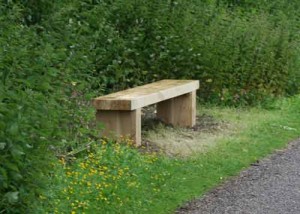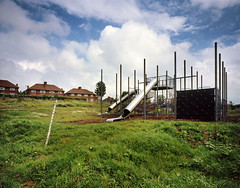 When Dame Jennifer Jenkins was appointed to chair the UK National Trust she commented that the main criticism of the gardens they manage is that ‘They are all the same’. It is not quite true but they do have an alarming similarity. This was brought home by visits to some visits to Yorkshire gardens this year. Studley Royal, run by the National Trust, has not had the ‘curse of Sissinghurst’ laid upon it. Of course I love Sissinghurst and of course it attracts busloads of visitors, but I do not want to see England’s historic gardens getting ever more like Sissinghurst. Studley Royal retains its independent dignity but it IS getting more National Trusty. Perhaps the paths are being too well kept; perhaps too many seats are appearing; perhaps that terrible Visitor Centre has an existence outside my drawer of garden nightmares. I can see that the architect had a lot of fun but the National Trust does not exist for this purpose. Its not such an ugly building: it just does not belong at Studley Royal.
When Dame Jennifer Jenkins was appointed to chair the UK National Trust she commented that the main criticism of the gardens they manage is that ‘They are all the same’. It is not quite true but they do have an alarming similarity. This was brought home by visits to some visits to Yorkshire gardens this year. Studley Royal, run by the National Trust, has not had the ‘curse of Sissinghurst’ laid upon it. Of course I love Sissinghurst and of course it attracts busloads of visitors, but I do not want to see England’s historic gardens getting ever more like Sissinghurst. Studley Royal retains its independent dignity but it IS getting more National Trusty. Perhaps the paths are being too well kept; perhaps too many seats are appearing; perhaps that terrible Visitor Centre has an existence outside my drawer of garden nightmares. I can see that the architect had a lot of fun but the National Trust does not exist for this purpose. Its not such an ugly building: it just does not belong at Studley Royal.
From Studley Royal I went to Bramham Park – and was delighted to see how un-National Trusty it remains. In parts the standard of maintenance is higher then the National Trust would attempt. In other parts is is lower. In other parts, like the tennis court on the front lawn, it is entirely as the resident family wish it to be. It is a real garden.
Chatsworth Garden was also a pleasure to visit. Apart from its unique historic character, it has an individuality which, I can only assume, results from the kindly care lavished upon the estate by the Devonshire family. The food was also a great deal better and cheaper than in a National Trust multiple.
These considerations remind me that a friend of my grandfather’s was one of the National Trust’s first 100 members. In the 1950s, they both resigned with the explanation, in my grandfather’s words, that ‘They will be just like the monasteries, and all monopolies, when they get too large and too wealthy, they become lazy and corrupt’. He thought the National Trust was doing too much to become larger with ever more jobs for ever more boys and ever more girls. Instead, he argued for a plethora of smaller trusts each with its own role and its own policies. I think he was right.
Let us hope the National Trust’s new chairman, Sir Simon Jenkins, can do something more effective about the problem than Dame Jennifer Jenkins. He has long argued for effective devolution from Westminster to the regions. The problem he faces is that the great estates can’t very well be returned to their ancient families. One thing he could and should do is rid the National Trust of fawningly busybody interference of the kind pioneered by Graham Stuart Thomas during his reign as gardens advisor to the National Trust.
 Some predict that as the polar ice caps melt major cities such as London, New York and Bangkok will be flooded.
Some predict that as the polar ice caps melt major cities such as London, New York and Bangkok will be flooded.



